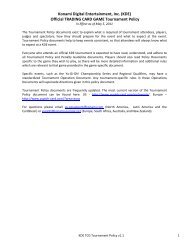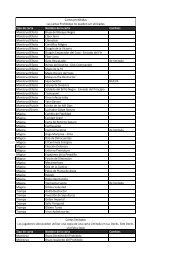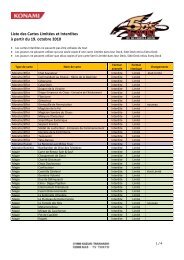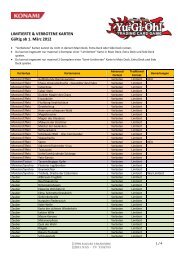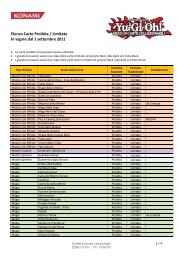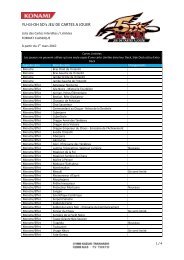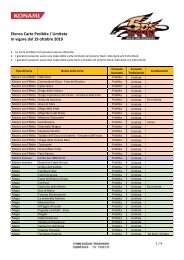The USSR-Russia Fast-Neutron Reactor ProgramThe BR-2 was replaced with <strong>the</strong> BR-5 (5 MWt), 7 and commenced operations in1959. It was cooled with liquid sodium and fueled with plutonium dioxide toallow higher fuel temperatures and power densities (up to 500 kilowatts/liter)in <strong>the</strong> core. 8 The BR-5’s power was subsequently increased to 10 megawatt<strong>the</strong>rmal (MWt) and it operated until 2004. In addition to reactor research anddevelopment, <strong>the</strong> BR-5 was used <strong>for</strong> medical-isotope production and even medicaltreatment (neutron-capture <strong>the</strong>rapy <strong>of</strong> throat cancer using neutron beams from<strong>the</strong> reactor).Second and third decades, 1960-80During <strong>the</strong> second and third decades <strong>of</strong> <strong>the</strong> program, experience was acquired in<strong>the</strong> use <strong>of</strong> fast-reactor technology.In 1961, <strong>the</strong> critical assembly BFS–1 started operation at IPPE. It allowedresearchers to simulate fast-reactor core volumes <strong>of</strong> up to 3 m 3 with cores fueledby different mixtures <strong>of</strong> plutonium and uranium <strong>of</strong> varying enrichments, anddifferent configurations <strong>of</strong> control and safety rods. It also allowed studies <strong>of</strong> <strong>the</strong>effects <strong>of</strong> sodium voids on reactivity and o<strong>the</strong>r physical effects. BFS-2, whichstarted operating at IPPE at <strong>the</strong> end <strong>of</strong> <strong>the</strong> 1960s, could simulate cores withvolumes up to 10 m 3 .A higher power special fuel-testing reactor, <strong>the</strong> BOR-60, was designed andconstructed in <strong>the</strong> Institute <strong>of</strong> Atomic Reactors (Dimitrovgrad) in five years andbegan operating in 1969. Vibro-packed fuel was tested in this reactor. It is stilloperational.Between 1962-1964, <strong>the</strong> future direction <strong>of</strong> Soviet nuclear energy developmentwas studied. A main concern was conservation <strong>of</strong> uranium resources. The studyconcluded that a “promising perspective is expansion <strong>of</strong> nuclear energy using fastbreeder reactors starting with enriched uranium fuel and step-by-step replacementwith plutonium fuel.”A demonstration project was initiated even be<strong>for</strong>e <strong>the</strong> BR-5 began operating.Initially <strong>the</strong> demonstration reactor was named BN-50 (50 MWt) but later <strong>the</strong>power was increased to 1000 MWt. The reactor came to be called BN-350 <strong>for</strong>its equivalent electrical output. 9 The design <strong>of</strong> <strong>the</strong> demonstration BN-350 and asignificant number <strong>of</strong> experiments at <strong>the</strong> BFS-1 critical assembly were completedbe<strong>for</strong>e construction started in 1964. 10 The Minister <strong>of</strong> Atomic Energy, Yefim P.Slavsky, decided to build <strong>the</strong> reactor on <strong>the</strong> Mangyshlak peninsula on <strong>the</strong> CaspianSea. The heat was used <strong>for</strong> desalination as well as electricity generation. It wasfueled with uranium enriched up to 20-25 percent uranium-235 and with mixedoxideuranium-plutonium (MOX) test fuel assemblies. It began operations in1972.64
300314551 Martin Tr?ek 38 Nationals Slovenia - 25.5.<strong>2013</strong> May 25, <strong>2013</strong> via passed down301897787 Tom Tracey 1 Preston - 310100 March 02, <strong>2013</strong> classified by rank300640007 Liborio Trainito 15 Legnano - 170272 March 10, <strong>2013</strong> via passed down300747420 DANIEL TRAN 9 Vernon December 16, 2012 classified by rank300498570 Duc Tran 4 Mainz November 24, 2012 classified by rank300035688 Johnny Tran 33 <strong>WCQ</strong> Nationals <strong>2013</strong> - Sweden May 18, <strong>2013</strong> via passed down303003421 Kiyoka Tran 1 <strong>WCQ</strong> Regional - Comics Lade <strong>2013</strong>-06-01 June 01, <strong>2013</strong> classified by rank300645259 paolo trapani 9 <strong>WCQ</strong> Regional - Bologna <strong>2013</strong>-03-10 March 10, <strong>2013</strong> classified by rank302808721 Roberto trecarichi 4 Legnano - 170272 March 10, <strong>2013</strong> classified by rank301436595 Christopher Treil 22 <strong>WCQ</strong> Regional - Lyon <strong>2013</strong>-02-23 February 23, <strong>2013</strong> via passed down300452386 Sam Tribbensee 13 Sheffield - 310018 February 23, <strong>2013</strong> classified by rank302386205 Mads Trier 1 Kolding - 080009 February 16, <strong>2013</strong> classified by rank301380160 Iliyan Trionov 10 <strong>WCQ</strong>: Bulgarian National Championship <strong>2013</strong> June 02, <strong>2013</strong> classified by rank300036086 Alexander Trivedi 5 Helsinki November 25, 2012 via passed down301270009 Gleb Trubitcoi 24 <strong>WCQ</strong> National <strong>2013</strong> - Portugal June 15, <strong>2013</strong> classified by rank300039443 Stefan Tsachev 7 <strong>WCQ</strong> National Championship <strong>2013</strong> - Malta June 09, <strong>2013</strong> classified by rank301111761 Gershon Tsaitlin 15 <strong>WCQ</strong> Regional - Tel Aviv <strong>2013</strong>-03-28 March 28, <strong>2013</strong> via passed down302029727 Thalis Tsakiridis 54 <strong>WCQ</strong> Nationals <strong>2013</strong> - Greece June 23, <strong>2013</strong> via passed down302026114 Stavros Tsalikis 2 <strong>WCQ</strong> Regional - Halkida <strong>2013</strong>-06-05 June 05, <strong>2013</strong> classified by rank300816759 Nikos Tsalis 57 <strong>WCQ</strong> Nationals <strong>2013</strong> - Greece June 23, <strong>2013</strong> via passed down301493444 Will Tseng 27 Preston - 310100 March 02, <strong>2013</strong> via passed down301125511 Shimon Tseylin 7 Tel-Aviv - 160001 February 25, <strong>2013</strong> classified by rank300012585 Vasilis Tsimperis 16 <strong>WCQ</strong> Nationals <strong>2013</strong> - Greece June 23, <strong>2013</strong> classified by rank300324007 Kimonas Tsitsiridis 1 <strong>WCQ</strong> Regional - Hobby Games <strong>2013</strong>-06-07 June 07, <strong>2013</strong> classified by rank303699289 Thanasis Tsourakis 24 <strong>WCQ</strong> Nationals <strong>2013</strong> - Greece June 23, <strong>2013</strong> classified by rank300993655 Pham Tuan 9 Frankfurt December 29, 2012 classified by rank302096987 TOM TUBBAX 21 Belgium National May 18, <strong>2013</strong> classified by rank303678291 Lucas Tuch 3 UK Dragon Duel Championship <strong>2013</strong> May 18, <strong>2013</strong> classified by rank300528056 MITCHELL TUDOR 9 <strong>WCQ</strong> Regional - Angers <strong>2013</strong>-03-17 March 17, <strong>2013</strong> classified by rank300550998 Christian Tulli 13 <strong>WCQ</strong> Regional - Terni <strong>2013</strong>-03-24 March 24, <strong>2013</strong> via passed down301121107 Lewis Tulodziecki 4 Bristol November 10, 2012 classified by rank301832843 Daniele Tumbarello 13 <strong>WCQ</strong> Regional - Pianezza <strong>2013</strong>-05-26 May 25, <strong>2013</strong> via passed down301228471 Marko Turk 10 Nationals Slovenia - 25.5.<strong>2013</strong> May 25, <strong>2013</strong> classified by rank301698379 Kadri Turker 4 istanbul - 330005 February 03, <strong>2013</strong> classified by rank301404201 Charlie Turner 1 Kempston December 08, 2012 classified by rank300151699 Mirko Turriziani 9 <strong>WCQ</strong> Regional - Napoli <strong>2013</strong>-04-28 April 28, <strong>2013</strong> via passed down300455987 Ross Turton 74 <strong>2013</strong> UK National Championship May 18, <strong>2013</strong> via passed down





